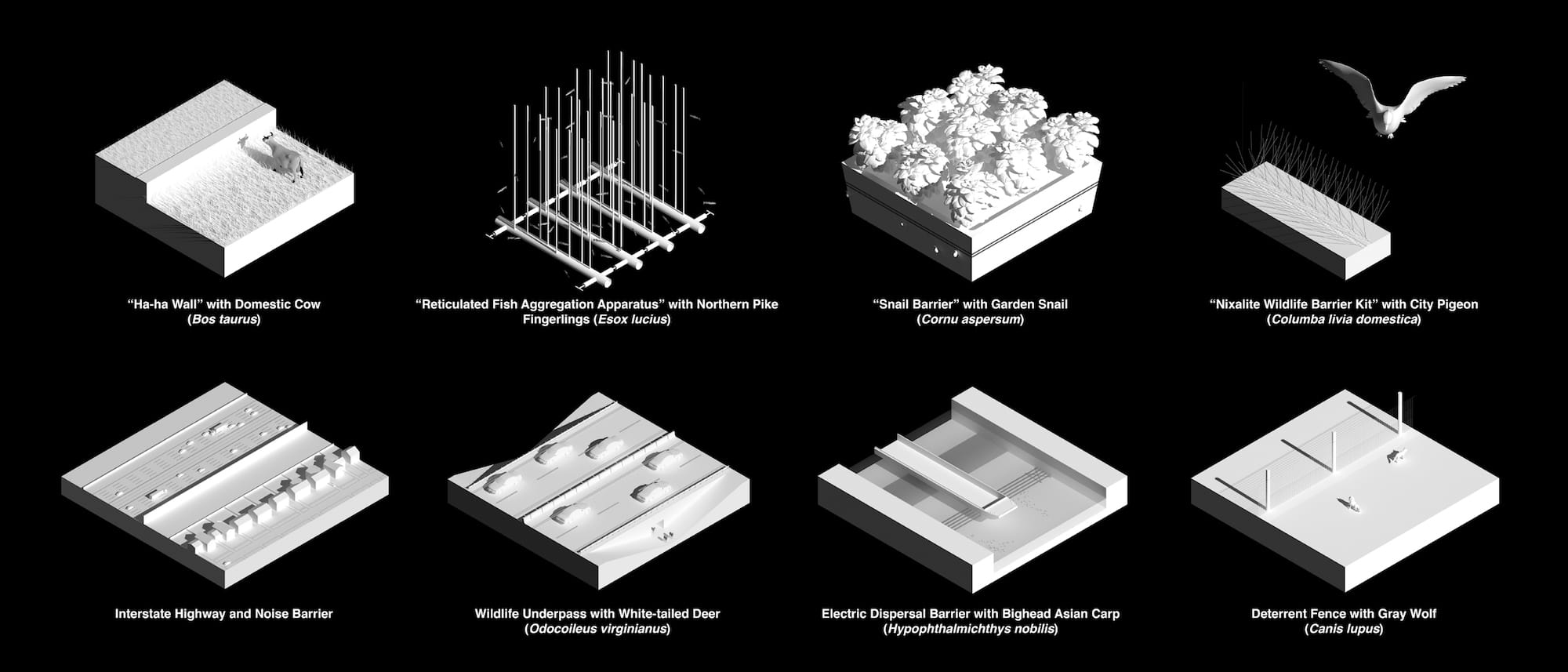
“Some animals should be seen as forming separate sovereign communities on their own territories (animals in the wild vulnerable to human invasion and colonization); some animals are akin to migrants or denizens who choose to move into areas of human habitation (liminal opportunistic animals); and some animals should be seen as full citizens of the polity because of the way they’ve been bred over generations for interdependence with humans (domesticated animals). All of these relationships…have their own moral complexities that can be illuminated by using ideas of sovereignty, denizenship, migration, territory, memberships, and citizenship.” -Sue Donaldson and Will Kymlicka, Zoopolis [1]
From the scale of the domestic garden to regional infrastructure, America’s built environment comprises a range of physical barriers that, both intentionally and inadvertently, include or exclude animals. Establishing and maintaining political jurisdictions, infrastructural networks, or recreational areas often relies on the suppression or redesign of conflicting existing ecosystems. Barriers are intentionally constructed to exclude particular animal communities from human ones, while still others become unintentional obstacles, fragmenting habitat and disrupting natural animal ranges. Sometimes other elements in the built environment, however, are designed to be inclusive, and integrate anthropogenic with non-human realms.
Considering Non-Human Citizenship presents differing scales of elements in the built environment that suppress, exclude, or include fauna.
Individual Component Captions (From left to right, top to bottom)
“Ha-ha Wall” with Domestic Cow (Bos taurus)
“Reticulated Fish Aggregation Apparatus” with Northern Pike Fingerlings (Esox lucius)
“Snail Barrier” with Garden Snail (Cornu aspersum)
“Nixalite Wildlife Barrier Kit” with City Pigeon (Columba livia domestica)
“Interstate Highway and Noise Barrier”
“Wildlife Underpass” with White-tailed Deer (Odocoileus virginianus)
“Electric Dispersal Barrier” with Bighead Asian Carp (Hypophthalmichthys nobilis)
“Deterrent Fence” with Gray Wolf (Canis lupus)
Notes
[1] Sue Donaldson and Will Kymlicka, Zoopolis: A Political Theory of Animal Rights (Oxford: Oxford University Press, 2011), 14.
[2] Ha-hall wall model represents general type.
[3] Modeled after Jack D. Smith, Reticulated fish aggregation apparatus, US Patent 6,523,497, filed December 13, 2000, and issued February 25. 2003.
[4] Modeled after John W. Cutter, Snail barrier, US Patent 4,756,116, filed November 2, 1987, and issued July 12, 1988.
[5] Modeled after “Nixalite Wildlife Barrier Kit (Premium Model S Nixalite Bird Spike), nixalite.com/nixalite-models.
[6] Modeled after Google Earth satellite photos and Google Street View of US Interstate 90 in Hoffman Estates, Cook County, Illinois. I-90 and the adjacent sound barriers separate the Paul Douglas Forest Preserve of Cook County on the north from single-family homes to the south.
[7] Modeled after 2013 site visit; Google Earth satellite photos; Google Street View; and underpass #1 described in Lydia Rogers et al., “Wildlife Tunnels Under a Busy, Suburban Boston Roadway,” 1-19, concordma.gov/DocumentCenter/Home/View/3763.
[8] Represents recent efforts to prevent the Asian Carp from reaching the Great Lakes via the Chicago River. Modeled after United States Army Corps of Engineers, “The Electric Dispersal Barriers,” November, 2011, 1-6, www.lrc.usace.army.mil/Portals/36/docs/projects/ans/docs/ElectricBarrierBrochure.pdf.
[9] Modeled after Donald G. DeLorenzo, “Fencing Against Coyotes,” Extension Circular 916. Oregon State University Extension Service, (January 1977) 1-3, ir.library.oregonstate.edu/downloads/tb09j596c.
Conor O’Shea
Conor O’Shea’s design, research, and teaching explore and develop landscape strategies for more ecologically robust and socially equitable urban environments. His areas of interest include the urbanization of the hinterland, operational landscapes, logistics landscapes, and the geography of freight transportation in North America. He is Assistant Professor in the Department of Landscape Architecture at the University of Illinois at Urbana-Champaign, where he directs the Landscape Strategies Laboratory. He is also founder of Hinterlands Urbanism and Landscape. hinterlands-ul.net | @ceoshea773